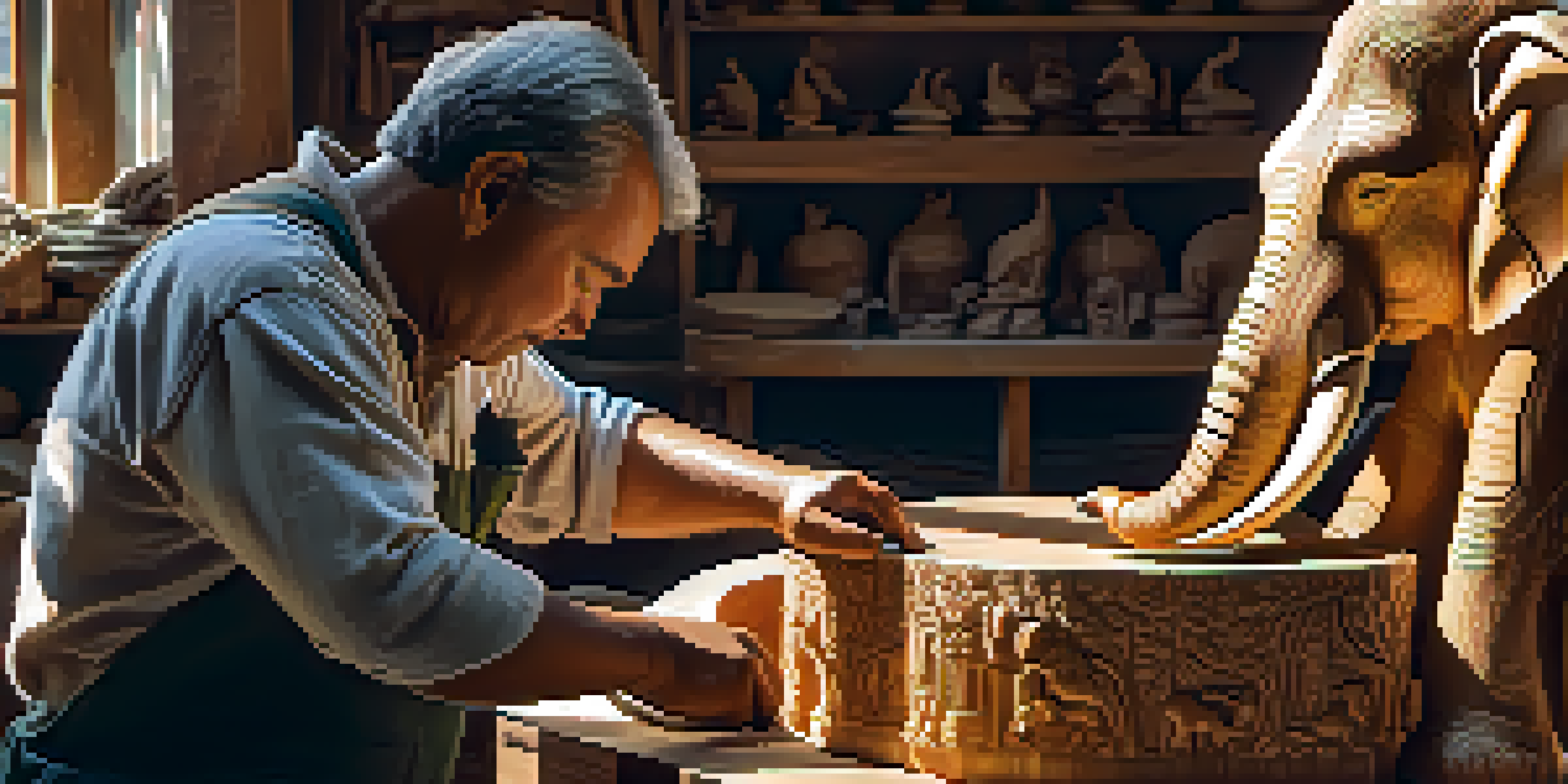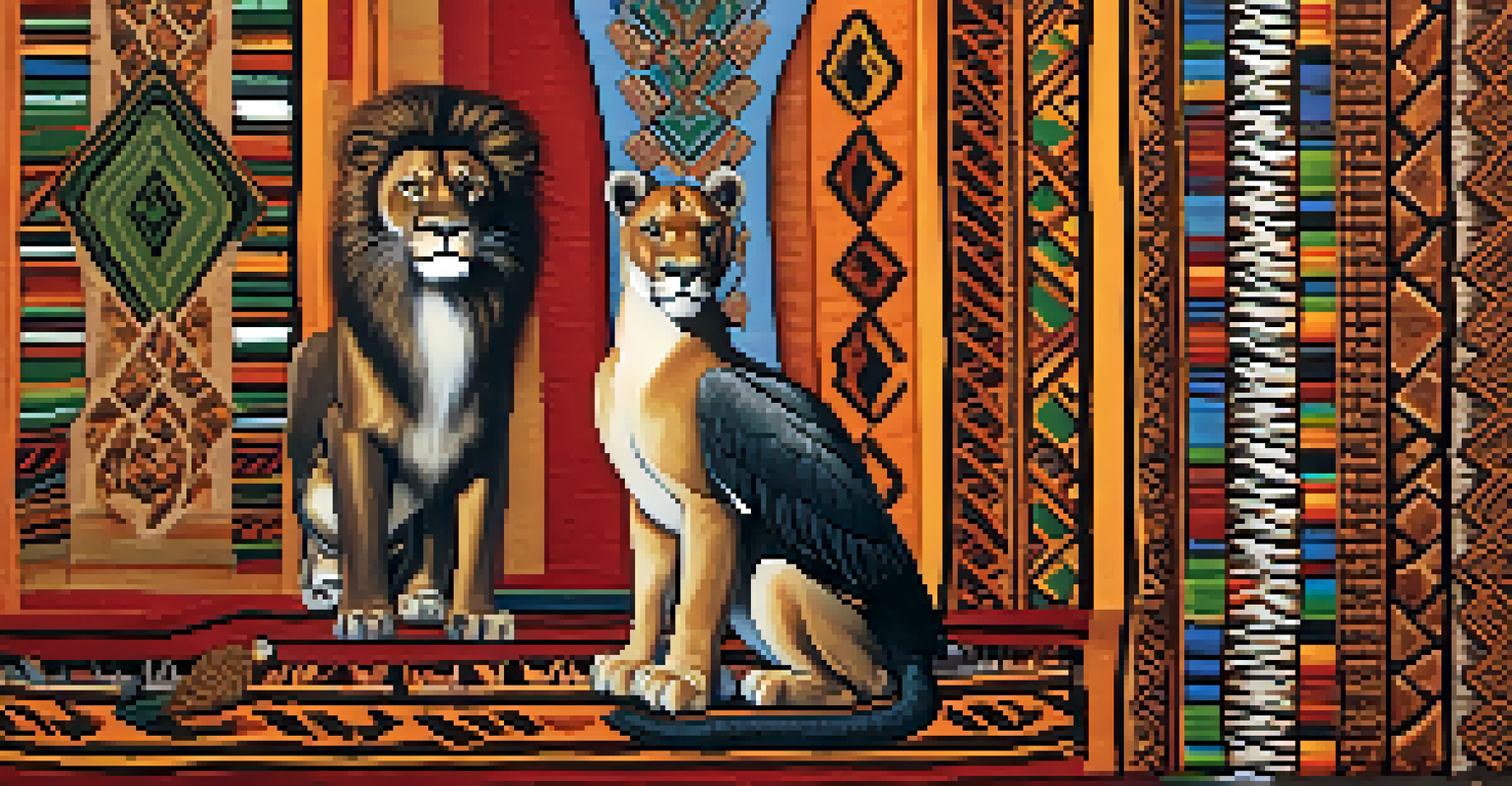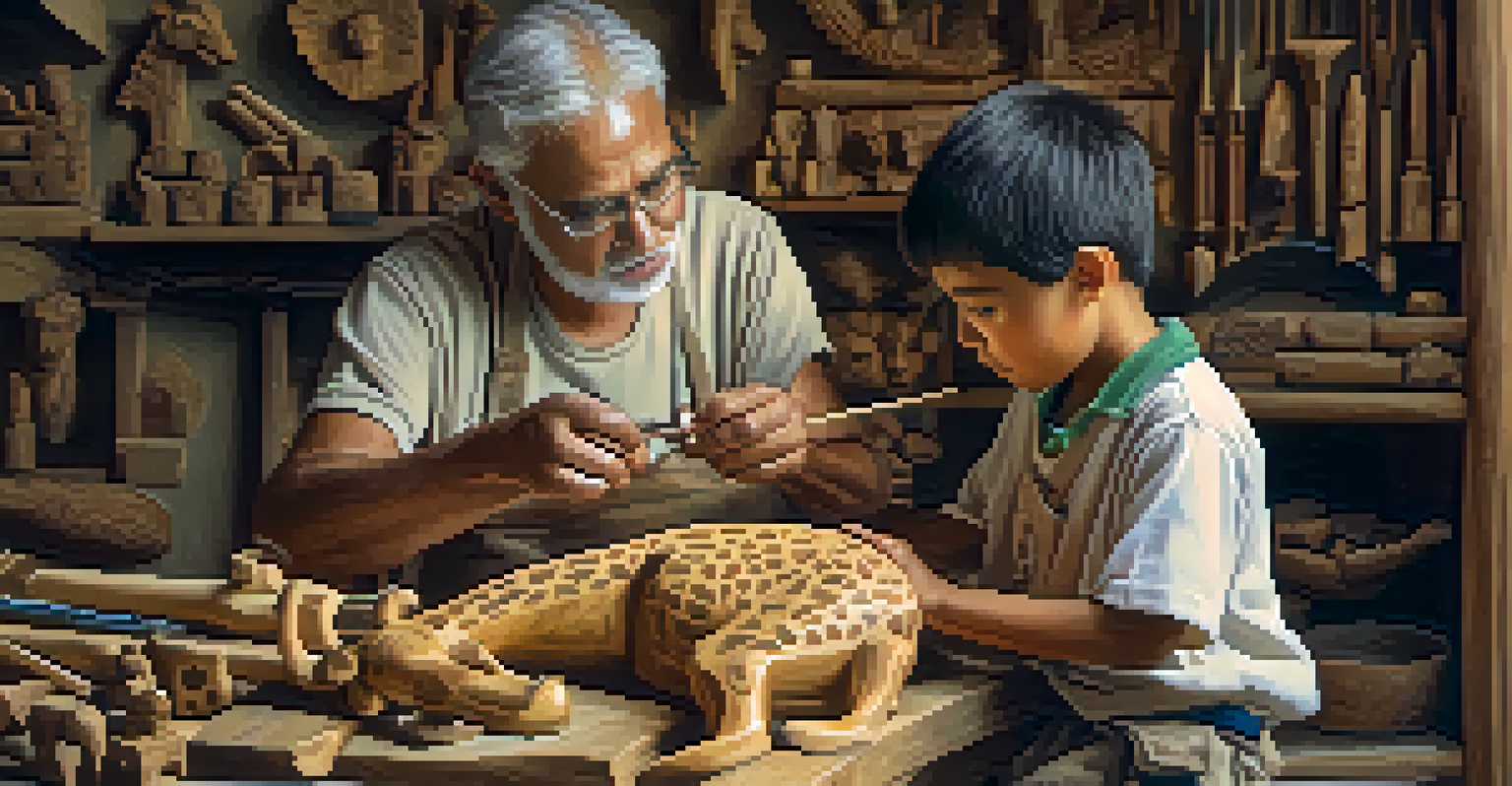Traditional Animal Carving Techniques in African Cultures

Understanding the Origins of Animal Carving in Africa
Animal carving in African cultures has deep historical roots, often linked to spiritual beliefs and traditions. These carvings are not just artistic expressions; they serve as symbols of power, protection, and connection to the divine. Many communities believe that these animals hold spiritual significance, representing ancestors or embodying traits desirable in humans.
Art is the most beautiful of all lies; it is a representation of the world as it ought to be, not as it is.
For instance, the lion is often depicted in carvings as a symbol of strength and courage, while the elephant represents wisdom and loyalty. This connection between the animal and its symbolic meaning adds layers of depth to the craftsmanship. Artists infuse their work with cultural narratives, passing down stories through generations.
As we explore this ancient practice, it becomes clear that each carving is a testament to the community’s identity and values. These artworks are not just decorative; they are vital storytelling tools that keep traditions alive and foster a sense of belonging within the community.
Materials Used in Traditional African Animal Carvings
The choice of materials in animal carving varies across different African cultures, often influenced by local resources and traditions. Common materials include wood, bone, ivory, and stone, each selected for its own unique properties and significance. For example, hardwoods are preferred for their durability and ability to hold intricate details.

In some regions, artisans may use softer woods for smaller carvings, allowing for finer details and delicate designs. Meanwhile, ivory, although controversial today due to ethical concerns, was historically prized for its smooth texture and aesthetic appeal. Each material not only adds to the visual quality of the carvings but also reflects the community's connection to their environment.
Cultural Roots of Animal Carvings
Animal carvings in Africa serve as symbols of spiritual beliefs, community identity, and storytelling.
The process of gathering and preparing these materials is often steeped in tradition, with practices passed down through generations. This deep respect for materials enhances the value of the final piece, making each carving a unique blend of nature, culture, and artistry.
The Role of Ancestral Knowledge in Carving Techniques
Ancestral knowledge plays a crucial role in the techniques employed by traditional carvers. Many artisans learn their skills through apprenticeship, working closely with experienced elders who impart not only crafting skills but also cultural narratives and spiritual teachings. This mentorship ensures that the art form remains authentic and deeply rooted in tradition.
The artist is not a special kind of person; each of us is a special kind of artist.
The techniques passed down can vary significantly between regions, influenced by local customs and the types of animals that are significant to each community. For instance, the precision in carving a zebra's stripes may differ from the way a giraffe's neck is portrayed, reflecting the unique relationship each culture has with its fauna.
This blend of technical skill and cultural storytelling creates an enriching learning experience for young artisans. They not only learn how to carve but also the significance behind each design, ensuring that both the craft and its cultural heritage are preserved for future generations.
Symbolism Behind Animal Carvings in African Cultures
Animal carvings often carry profound symbolism in African cultures, serving as powerful representations of beliefs and values. Each animal is imbued with specific meanings that reflect the community's worldview. For example, a carving of a tortoise may symbolize longevity and wisdom, while a hawk could represent vision and foresight.
These symbols play a vital role in rituals, ceremonies, and daily life, acting as reminders of the traits that communities aspire to embody. The carvings are frequently used in traditional ceremonies, where they are offered as gifts or used as spiritual icons to invoke protection and blessings.
Materials Reflect Cultural Values
The choice of materials for carving, such as wood and ivory, is influenced by local resources and cultural traditions.
Understanding the symbolism behind these carvings enhances appreciation for the artistry involved. It transforms the act of carving into a meaningful practice, connecting the artisan, the community, and the spiritual realm in a shared narrative.
Regional Variations in African Animal Carving Styles
Africa is a continent rich in diversity, and this is vividly reflected in the regional variations of animal carving styles. Each area boasts unique techniques, aesthetics, and preferred animals, influenced by local cultures and environments. For instance, West African carvings may be more abstract, while East African artisans often focus on realistic representations.
In Southern Africa, the Ndebele people are known for their vibrant, geometric designs that incorporate animal motifs, showcasing a blend of color and form. Meanwhile, the Maasai of Kenya often craft stylized figures that emphasize the elegance and stature of animals like cattle, which are central to their culture.
These regional differences not only highlight the skill of individual artisans but also emphasize how communities express their identity through art. Exploring these variations provides a broader understanding of the continent's artistic heritage, revealing the rich tapestry of Africa's cultural landscape.
Contemporary Influences on Traditional Carving Techniques
In recent years, traditional animal carving techniques have encountered contemporary influences that are reshaping the art form. Globalization has introduced new materials, tools, and styles, prompting artisans to innovate while still honoring their cultural heritage. Some carvers have begun to incorporate modern themes or hybrid techniques that appeal to a broader audience.
While this evolution can enhance the visibility of traditional crafts, it also raises questions about authenticity and the preservation of cultural identity. Many artisans strive to find a balance between innovation and tradition, ensuring that their work continues to tell the stories of their ancestors.
Preserving Art Through Education
Community workshops and educational programs are essential for passing down traditional carving techniques to future generations.
This dynamic interplay between tradition and modernity creates a vibrant art scene, where traditional carvers can reach new markets and audiences. The challenge lies in maintaining the integrity of their craft while adapting to changing times, ensuring that the essence of their cultural narratives remains intact.
Preserving Traditional Carving Techniques for Future Generations
Preserving traditional animal carving techniques is essential for maintaining cultural heritage in African societies. As modern influences and changing lifestyles impact traditional practices, efforts are being made to safeguard these valuable skills. Community workshops, educational programs, and cultural festivals play a pivotal role in passing down knowledge to younger generations.
Many communities are recognizing the importance of documenting these techniques and the stories behind them, using digital platforms to share their heritage with a global audience. This not only promotes appreciation for the art form but also creates a sense of pride within the community.

By fostering an environment where traditional carving is valued and taught, these cultures can ensure that their unique practices endure. The hope is that future generations will continue to carve not just animals, but also the rich narratives of their people, keeping their stories alive for years to come.